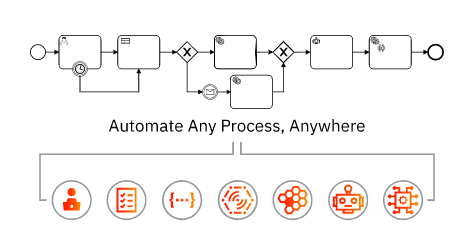The discipline of business process management (BPM) has been around for a long time; as long as people have been trying to discover, analyze, model, automate and improve the processes that exist within their organization. A decade ago, BPM practices focused on modeling stable, repeatable processes for administrative and support functions such as accounting, finance, HR and IT services (often called “the back office”). Business process management suites (BPMS) emerged as tools to support process modeling and limited automation of these back-office processes.
Today, the concept of a “business process” goes well beyond the back office. Companies in industries such as insurance, telecommunications, banking and more are applying the practices of process modeling and automation to the customer-facing processes that make up the core of their business. However, many organizations have found that the BPMS they’ve used to manage back-office processes isn’t suited for the dynamic, variable, fast-changing processes that are now critical for their core business.
Five Trends Impacting Business Process Management
- Digital transformation is reshaping businesses. The Enterprisers Project defines digital transformation as “the integration of digital technology into all areas of a business, fundamentally changing how you operate and deliver value to customers. It’s also a cultural change that requires organizations to continually challenge the status quo, experiment and get comfortable with failure.” To make these changes, organizations are racing to take advantage of new technology, build new revenue streams, and create meaningful, real-time digital relationships with their customers, partners, suppliers, employees and the overall ecosystem in which they operate. Organizations that cannot transform are quickly left behind.
- Customers are increasingly digital. Fifty years ago, a customer would have to make a call or send a letter to update their address or change their order. Today, customers want to do these things – and more – digitally, as IT has proliferated through every aspect of their daily lives. From online shopping to social media apps, payment apps to smart speakers, the rise of consumer IT has reset consumer expectations and has raised the bar for what enterprise IT is expected to deliver to the business.
- Automation matters. Automating tasks that have previously been done by people can reduce operational costs, reduce error rates, increase consistency, ensure compliance, and allow employees to focus on strategic, value-adding activities instead of repetitive manual work.
- The ROI of automation matters. According to a recent survey of IT decision makers commissioned by Camunda, 89% have seen increased business growth due to process automation over the past year. In fact, 39% of decision makers say they have seen an increase of 51% to 100% ROI due to process automation, and 21% have seen more than 1x ROI. It’s therefore not surprising that 88% of IT decision makers say their organization plans to increase investment in process automation over the next 24 months.
- Architecture matters. Legacy software and systems are no longer an IT problem; they’re a significant roadblock to transformation of your entire business. Legacy BPM software in particular is often inflexible and expensive, which limits your ability to react to changes in your market and hinders the ROI of your automation efforts. Legacy infrastructure can also prevent you from scaling up your capacity to deliver high-quality digital experiences to your customers.
Why You Need Process Automation
Digital transformation is necessary to keep up with the market and deliver experiences that keep customers coming back to your business again and again. The key to making digital transformation work is process automation. Process automation might have its roots in BPM, but it goes beyond the stable, repeatable back-office processes of the past. Instead, process automation enables you to transform the mission-critical, customer-facing processes that make up the core of your business.
A key difference between process automation and BPM is that BPM is typically limited to the automation of siloed tasks that belong to one department and require few IT systems, whereas process automation supports business processes from start to finish across departments, and across diverse systems and endpoints.
As Camunda CEO, Jakob Freund, recently wrote for Forbes:
“Automation means much more than just robotic process automation (RPA) bots. It requires end-to-end process automation with an orchestration layer to tie together a series of API-connected processes. Mastering this process from the outset makes automation as easy as connecting these APIs across the organization.”
End-to-end process orchestration ensures you can visualize, monitor, control, and improve business processes in a way that just isn’t possible with siloed, task-oriented automation.
Learn More
To learn more about the evolution of business process management and process automation, check out The Business Process Management Renaissance.

